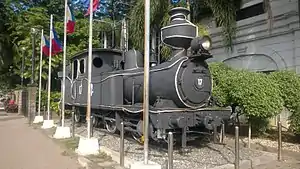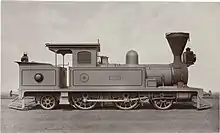Manila Railway Dagupan class
The Manila Railway Dagupan class of 1890 were thirty 0-6-2 side tank locomotives.[1] Thirty locomotives were built for the Manila Railway Company between 1888 and 1890. They were the first true mainline locomotives in service of the Ferrocarril de Manila a Dagupan inter-city rail line, succeeding two of five Manila class light-duty locomotives. One of these locomotives, No. 17 Urdaneta, survives today on static display on an open-air museum in Dagupan, Pangasinan.
| Manila Railway Dagupan class | |||||||||||||||||||||||
|---|---|---|---|---|---|---|---|---|---|---|---|---|---|---|---|---|---|---|---|---|---|---|---|
 No. 17 Urdaneta, the sole surviving example. | |||||||||||||||||||||||
| |||||||||||||||||||||||
| |||||||||||||||||||||||
| |||||||||||||||||||||||
| |||||||||||||||||||||||
| References:[1] | |||||||||||||||||||||||
Background
The Luzon railroad system was originally proposed by Don Eduardo Lopez Navarro in 1875 and was approved by the Spanish East Indies government in 1880.[2] The company's operations then went under the process of bidding for concessionaires, with the British-owned Manila Railway Company winning the franchising rights to the system and will be built in 3 ft 6 in (1,067 mm) narrow gauge to save costs.[1]
During the construction of the line, light-duty Manila-class locomotives built by Hunslet Engine Company were used to carry passengers between Manila and Bulacan. Since the design was not suitable for long-distance travel, the British owners of the Manila Railway ordered several larger locomotives from Scottish manufacturers. Two manufacturers, Neilson and Company, and Dübs and Company; both based in Glasgow, won the orders for the locomotives. The class will be later known to Filipino railroad historians as the Dagupan class, after the northern terminus of the line.[3]
Design
There were two identical designs for the Dagupan class. Fifteen units were built for each subclass, differentiated by its livery and smokestack.
Nielson A subclass

The first subclass was exemplified by Borrecon above and built by Neilson in 1888 was classified by the Manila Railway as the A subclass. Compared to the later B subclass, it did not have a bell on the front of the locomotive. It also featured a different smokestack. According to postage stamps recovered by University of the Philippines historian Leonardo Q. Liongson, the Neilson class was originally painted black, with the side tank colored either metallic silver or white, and with an azure lining.[4]
Dübs B subclass
The second subclass' design is exemplified by Urdaneta, the only surviving unit. These were delivered to the Manila Railway in 1890 and was classified as the B subclass.[3] It features a more complex design compared to the A-subclass, with a bell and one of its boilers had its whistle attached to the sandbox. The design of the smokestack was also larger than the previous type, with a different spark arrestor and a narrower exhaust from the smokebox. Some designs such as the one used on the Stotsenburg Unlimited also featured a simple smokestack design without a spark arrestor.[5]
During their service with the Manila Railroad, the nameplate of named locomotives such as Urdaneta were removed and were replaced by the monogram of the Manila Railroad Company. To differentiate it from the A subclass, these locomotives were fully painted black except for a red-colored lining near the couplers.[6]
Service
The Neilson A subclass entered test services on the North Main Line (then known as Ferrocarril de Manila a Dagupan) by c. 1888, while the B subclass entered service by 1890. Each opened section is also opened for the trains.[1] During the Philippine–American War, these locomotives were used to carry United States Army troops towards the area of Central and Northern Luzon, chasing down the leaders of the Philippine Revolution such as Emilio Aguinaldo.[7] One train was destroyed with the locomotive being partially damaged near Angeles, Pampanga. Its status after the war was unknown.[8]
During the beginning of the American colonial period, the locomotives served express trains such as the Stotsenburg Unlimited between Manila and Fort Stotsenburg in Pampanga.[5] The Dagupan class became the primary locomotives in the 1900s and carried both passengers and freight.[9][10] According to the Railroad Gazette, the first-class cars the locomotives carried had windows and seating while the third-class cars were boxcars that were supposedly used by freight trains.[11]
Retirement
The arrival of larger tender locomotives from British and American manufacturers by the 1910s and the 1920s rendered the Dagupan class obsolete for flagship services. Along with the much-later 71-class that also featured the same 0-6-2 wheel configuration, they were relegated to switching duties in the 1920s.[12] As later stated by English engineer and Manila Railroad general manager Horace L. Higgins, the Manila Railway concession wanted bigger locomotives that weighed 40 to 45 short tons (36 to 41 t; 80,000 to 90,000 lb) and blamed the Spanish government for causing cost overruns.[1]
Some locomotives remained in service for switching and short-line duties under the Manila Railroad and were fully repainted black to signify their service to the MRR. This was evident with No. 17 Urdaneta. By 1954, the Manila Railroad started to decommission its steam locomotive fleet and the program was complete by the 1960s.
Preservation
No. 17 Urdaneta was the only survivor of the class. It was initially displayed by the Philippine National Railways in front of Tutuban station in Manila until it was transferred to Dagupan in 2005. The other units were then all scrapped by 1963.[13]
References
- Sartre, Gary. "The Cagayan Valley Railway Extension Project". Japan Railway & Transport Review. No. 22.
- Peris Torner, Juan (November 13, 2018). "Ferrocarril de Manila a Dagupan – Plan General de Ferrocarriles de la Isla de Luzón – Filipinas". Ferrocarriles de España (in Spanish). Retrieved October 21, 2020.
- Corpuz, Arturo (May 1989). Railroads and regional development in the Philippines: Views from the colonial iron horse, 1875–1935 (Thesis). Cornell University. Retrieved June 20, 2020.
- Liongson, Leonardo. "Daang Bakal Trains Vargas 2003". Retrieved October 22, 2020.
- "[Manila] North Line". Archived from the original on August 30, 2020. Retrieved October 22, 2020.
- Liongson, Leonardo. "Tranvia Train 2006". Retrieved October 22, 2020.
- Lane, George (February 22, 2016). "Manila Railroad in US Hands 1899". Retrieved October 22, 2020.
- Lane, George (February 22, 2016). "Train wrecked by insurgents near Angeles". Retrieved October 22, 2020.
- Lane, George (November 20, 2015). "Locomotive of the Manila-Dagupan RR ca 1900". Retrieved October 22, 2020.
- Lane, George (November 20, 2015). "Freight yard of the M&D RR in Manila ca. 1900". Retrieved October 22, 2020.
- "Rolling stock of the Manila Railroad Co. 1904". Railroad Gazette. Vol. Volume 45. 1904.
- Lane, George (November 18, 2015). "A flooded section at Alabang–Sucat c. 1920". Retrieved October 22, 2020.
- Kautzor, Thomas (May 23, 2013). "Today's Railways and Preserved Steam in the Philippines". Retrieved October 22, 2020.